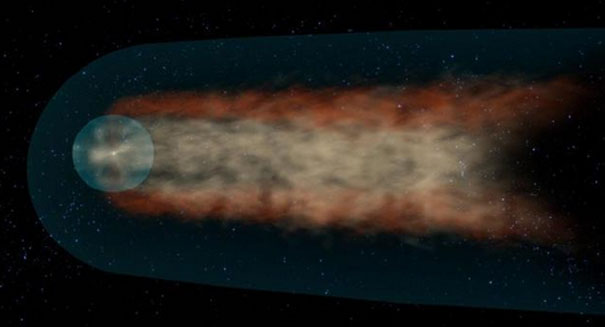
NASA's IBEX utilizes two new ENA cameras to take pictures of and map the heliosphere's global interaction.
The first images of our solar system’s tail have been revealed. According to a news release from the Southwest Research Institute, the space agency’s Interstellar Boundary Explorer spacecraft, also known as IBEX, recently obtained the first images of the solar system’s downwind region, showing a unique and rather surprising structure.
Astronomers have long though that, like a comet, a “tail” trails the heliosphere, the large bubble in which our solar system lives, as the heliosphere travels through interstellar space. The first IBEX images revealed in 2009 displayed an unexpected ribbon of exceptionally high energetic neutral atom emissions circling the upwind side of the solar system.
With the accumulation of more ENAs over the first year of observations, a structured dictated by lower energy ENAs came forth, which was initially described as the heliotail. However, astronomers noted that is was very small and looked to be offset from the downwind direction, possibly due to the interactions from the galaxy’s external magnetic field.
Over the next two years, additional IBEX data helped fill in the observational gap in the downwind direction. As the data came in, researchers discovered a second tail region to the side of the previously located one. The IBEX team reshuffled the IBEX maps and two similar, low-energy ENA structures became visible straddling the downwind direction of the heliosphere, showing structures that look more like “lobes” than a single unified tail.
According to Dave McComas, IBEX principal investigator, “it may well be that these are separate structures bent back toward the downwind direction. However, we can’t say that for certain with the data we have today.”
The news release notes that the astronomers started using the terms port and starboard to differentiate the lobes, as the heliosphere is the “ship” that moves our solar system throughout the galaxy.
IBEX data reveals that the Sun’s slow solar wind flows down the tail in the port and starboard lobes at low- and mid-latitudes and the fast solar wind heads down it at high northern and southern latitudes.
“We’re seeing a heliotail that’s much flatter and broader than expected, with a slight tilt,” notes McComas. “Imagine sitting on a beach ball. The ball gets flattened by the external forces and its cross section is oval instead of circular. That’s the effect the external magnetic field appears to be having on the heliotail.”
NASA’s IBEX utilizes two new ENA cameras to take pictures of and map the heliosphere’s global interaction.

Leave a Reply